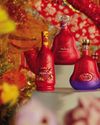
During the 18th and 19th centuries, affluent consumers in China often prized a peculiarly stylish form of the timepiece—distinctively decorative and novel pocket watches created by Swiss and British watchmakers—as a potent symbol of status and influence. Following the Communist Revolution of 1949, however, as western affectations and luxuries quickly fell out of favor, most of these remarkable watches disappeared or were sold off overseas.
Now Chinese collectors are on a mission to bring what remained of these cultural treasures home. Often featuring illustrated enamel dials and cases decorated with florid engraving, jewels and other glittering embellishments, Chinese-market pocket watches stood in stark contrast to the more restrained, functional timepieces usually created for European consumers. The most sought-after examples feature motifs of music, chimes and more complex automatons such as mechanically animated people, animals and scenery.
Western mechanical clockwork first came to China at the end of the Ming dynasty. In the late 16th century, a Jesuit missionary named Matteo Ricci, who hoped to convert China to Christianity, ingratiated himself with the Wanli emperor, who reigned from 1573 to 1620, with the gift of a watch and a chiming clock. A centuries-long imperial fascination with horology commenced, with subsequent Chinese rulers accumulating vast collections of intricate timepieces, and their courtiers and wealthy merchants following suit as much as their comparatively meagre means allowed.
Diese Geschichte stammt aus der June 2020-Ausgabe von Tatler Singapore.
Starten Sie Ihre 7-tägige kostenlose Testversion von Magzter GOLD, um auf Tausende kuratierte Premium-Storys sowie über 8.000 Zeitschriften und Zeitungen zuzugreifen.
Bereits Abonnent ? Anmelden
Diese Geschichte stammt aus der June 2020-Ausgabe von Tatler Singapore.
Starten Sie Ihre 7-tägige kostenlose Testversion von Magzter GOLD, um auf Tausende kuratierte Premium-Storys sowie über 8.000 Zeitschriften und Zeitungen zuzugreifen.
Bereits Abonnent? Anmelden

Rohit Jha
Using lasers and a proprietary shoebox-sized device, this technopreneur’s company Transcelestial seeks to increase connectivity speeds and access around the globe—and soon, beyond it

Fashioning Heritage
Aqilah Zailan founded Studio Gypsied to honour her Javanese heritage and ancestral narratives, reimagining batik into everyday designs

Sound System
Through music and mentoring, ArtSee bridges cultural and educational gaps, nurturing marginalised youth and preserving heritage for future generations. Co-founder Nabillah Jalal reflects on its impact and vision to extend its reach to more communities

Island in the Sun
With its beachfront location and proximity to Singapore, and access to international schools and healthcare infrastructure, Batu Ferringhi makes for an ideal investment destination. Sean Lim of NWD Holdings tells us about the Singapore-based investment group's upcoming hospitality development in Penang

On the Flower Trail
Twenty years after their first collaboration, Louis Vuitton and renowned Japanese artist Takashi Murakami reunite for a vibrant re-edition collection, blending art and fashion in a bold celebration of creativity and craftsmanship

Toast to the New Year
Fashion designer Shuting Qiu brings her vibrant colour palette and intricate designs to Hennessy's Chinese New Year 2025 exclusive releases, which will be showcased at the Crafted, by Hennessy travelling exhibition in Ion Orchard.

To the Moon and Back
Be captivated by the moonphase displays on these A Lange & Söhne timepieces—the ideal companions for cherished moments with loved ones this season

Dreamy Hues
The innovative colour-enhancing and ultra-moisturising Dior Addict Lip Glow now comes in 20 vivid and exciting shades

A Call for Connection
Virtuoso pianist and Rolex Testimonee Hélène Grimaud masterfully bridges the worlds of art and advocacy, using her evocative performances and commitment to conservation to inspire a deeper connection between humanity and the natural world

Eastern Influence
Pascale Lepeu, director of the Cartier Collection, reflects on Cartier's latest exhibition, Cartier, the Power of Magic